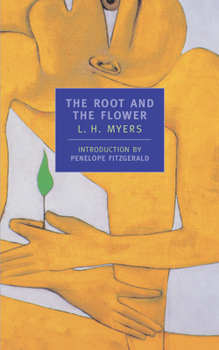The Root and the Flower
Select Format
Select Condition 
Book Overview
First published in 1935, this trilogy is set in exotic 16th-century India and records a succession of dynastic struggles during the reign of Akbar the great Mogul. It is an absorbing story of war,... This description may be from another edition of this product.
Format:Paperback
Language:English
ISBN:0940322609
ISBN13:9780940322608
Release Date:March 2001
Publisher:New York Review of Books
Length:656 Pages
Weight:0.25 lbs.
Dimensions:1.1" x 5.0" x 8.2"
Customer Reviews
1 rating
The Art and The Philosophy
Published by Thriftbooks.com User , 18 years ago
First off the mark, a slight disclaimer: I am of a very, very removed (to the nth degree, one might say) relative of this author, and while I was always aware of him and his father from an early age as the only authors in English literature slightly related to me, I always shied away from them because of 1) A dislike of the Theosophical twaddle for which the father is known and 2) A superstitious fear of what I might find that reminded me of myself, a fear that "blood will out" as it were. That having been said, I found this trilogy both enchanting, and tediously tendentious, by turns. The writing is superb throughout and the scenes depicted deliciously evocative. Even at its most tedious and ham-handed, the writing (almost) always manages to pull one through. A review of the three separate books on its own merits is, I think, the best way to go about reviewing this trilogy. They are very different, indeed, despite a superficial show of having the same characters in play and having the same Asiatic backdrop. Before embarking on this, however, it is necessary to put to rest a criticism that has been voiced concerning all three books: To wit, that Myers never went to India (though he did travel extensively and to nearby Ceylon) and is therefore unqualified to write a book about it. The book is set during the reign of the Emperor Akhbar in Sixteenth Century India, where nobody has been for quite some time. You may as well criticise an author for not travelling to 16th Century England or America. As is commonplace: "The past is a different country. They do things differently there." So, on to the books: 1.) The Near and the Far---This is my favourite of the three, though clearly, I think, not what my distant relative meant to be the best. This trilogy has been dubbed a philosophical novel, quite rightly so. But in this book, the philosophy, such as it is, complements rather than obtrudes into the beautiful passages and contains the characters to whom most mortals can relate: Hari and Sita. Both characters are flawed, in a sort of moral sense, that is. On the other hand, they are the only three-dimensional, fully fleshed out characters in the whole trilogy. As Sita puts it to herself, "She preferred to love, even if loving meant suffering." And who of us doesn't? 2.) Prince Jali----Here, things start to unravel for the book as a work of art. Prince Jali is thirteen years old and though the book is described as a "Bildungsroman" by Penelope Fitzgerald, with whom I disagree on just about everything, in the Introduction. It isn't. Jali is thirteen at the beginning as well at the end of the book, there is really no detectable change or growth or "coming of age" of the character, which is what a Bildungsroman is all about. The critics are right about this one: It's a very flimsily veiled philippic reflecting Myers's own experience with Bloomsbury and "artistic" groups in general. Also, a caveat for homosexual readers: You are bound to be





